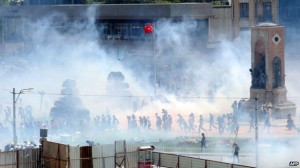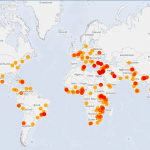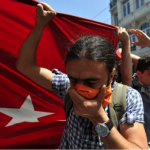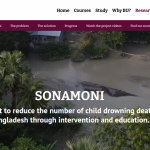 Over the past 100 years tear gas has been deployed to lure soldiers from hiding, to disperse demonstrations, halt robberies, quell riots, frighten protesters and confront hostage situations. Through these myriad uses, tear gas has grown into a global industry, serving as one of the major defence exports to international conflict zones. Yet while tear gas goes off around the world, its health effects remain undetermined, its death toll ill-defined and its legality, a recurring question.
Over the past 100 years tear gas has been deployed to lure soldiers from hiding, to disperse demonstrations, halt robberies, quell riots, frighten protesters and confront hostage situations. Through these myriad uses, tear gas has grown into a global industry, serving as one of the major defence exports to international conflict zones. Yet while tear gas goes off around the world, its health effects remain undetermined, its death toll ill-defined and its legality, a recurring question.
Responding to the need for more publicly accessible information on tear gas deployments, trade policies and health effects, my Fusion Fund mobility project ‘Fusing an International Research Network on Tear Gas’ is working to bring together researchers, NGOs, journalists and creative workers who address tear gas and related issues around chemical weapons, policing and control agents. Over the 2013-2014 year I will be working to form a research network to promote knowledge exchange between stakeholders and to lay the groundwork for future collaborative bids.
Our major project-in-the-works ‘Visualising Security and Uprising: Data, Democracy and Public Debate,’ will pair up innovative, digital media knowledge sharing techniques with findings derived from clinical trials, on the ground human rights monitoring, and archival data collection to generate publically accessible information on tear gas. The Network’s first presentation takes place in collaboration with Bahrain Watch this Thursday at Birmingham University’s Institute of Advanced Studies workshop event: Responding to Uprising: Urban Security Between Resilience and Resistance.
The Tear Gas Network is a collaborative initiative with a growing team, for more information or if you are interested in getting involved, please be in touch.
 Who are the World’s Heaviest Tear Gas Users?
Who are the World’s Heaviest Tear Gas Users? BU Civic Media Hub & the Omega Research Foundation publish report on the misuse of Tear Gas in Europe
BU Civic Media Hub & the Omega Research Foundation publish report on the misuse of Tear Gas in Europe










 Join the 17th Annual Postgraduate Research Conference – Wednesday 3 December 2025
Join the 17th Annual Postgraduate Research Conference – Wednesday 3 December 2025 BU Festival of Social Sciences invite at RNLI
BU Festival of Social Sciences invite at RNLI MaGPIE Presents at UK Parliament: From Mass Graves to Courtroom
MaGPIE Presents at UK Parliament: From Mass Graves to Courtroom Festival of Social Science: Introducing drowning prevention in Bangladesh
Festival of Social Science: Introducing drowning prevention in Bangladesh ECR Funding Open Call: Research Culture & Community Grant – Apply Now
ECR Funding Open Call: Research Culture & Community Grant – Apply Now MSCA Postdoctoral Fellowships 2025 Call
MSCA Postdoctoral Fellowships 2025 Call ERC Advanced Grant 2025 Webinar
ERC Advanced Grant 2025 Webinar Horizon Europe Work Programme 2025 Published
Horizon Europe Work Programme 2025 Published Horizon Europe 2025 Work Programme pre-Published
Horizon Europe 2025 Work Programme pre-Published Update on UKRO services
Update on UKRO services European research project exploring use of ‘virtual twins’ to better manage metabolic associated fatty liver disease
European research project exploring use of ‘virtual twins’ to better manage metabolic associated fatty liver disease
tear gas is very usefuul in contrys with conflits, but dont exist an information about problems to the health, in our research lab we use a software to choose the better way in gas research. Look that.
Regards
Andersson